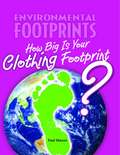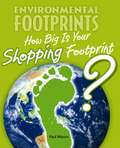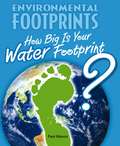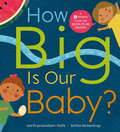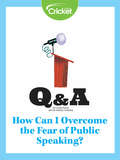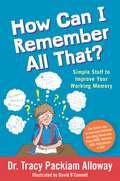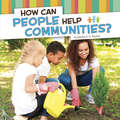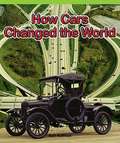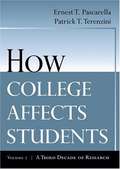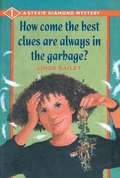- Table View
- List View
How Big Is It? A Big Book All About Bigness
by Ben HillmanWHAT'S THE BIG IDEA HOW BIG IS IT? A BIG Book All About BIGNESS How tall is a giraffe? 17.3 feet . . . or . . . If one was standing in your living room, you'd have to cut a hole in the ceiling, and its head would reach the top of a second-floor bedroom! Learn about big things like pyramids, diamonds in the sky, giant spiders, snakes, birds, flowers and more!
How Big Is Your Brave?
by Ruth SoukupHow do you teach a child to dream big and shoot for the stars? In this inspiring story, a young bunny named Zippy dreams of traveling to space. When the opportunity to attend space camp arrives, she worries she might not be capable enough to compete with other kids. But Zippy&’s desire to build her rocket is bigger than her fear of failing, and through hard work and creativity works to make her dreams come true.New York Times bestselling author Ruth Soukup empowers children everywhere to dream big and live a life they love. How Big Is Your Brave? encourages readers to face their fears and overcome obstacles in order to follow their dreams and reach their goals.How Big Is Your Brave? is:Great for boys and girls, ages 4–8An excellent choice for STEM storytime and sparking discussions about STEM fieldsA great resource to teach young children about confidence, self-esteem, and the value of hard workThrough whimsical illustrations and encouraging text, children will discover how standing up to fears (both big and small) makes them stronger and unstoppable.
How Big Is Your Clothing Footprint? (Environmental Footprints)
by Paul MasonWhat sort of footprint are you leaving on the environment? Do you have a heavy footprint or a light footprint? Everything we do and everything we use has an impact on the environment. Heavy footprints harm the environment and use lots of natural resources. Light footprints harm the environment as little as possible and use fewer natural resources. Read the ENVIRONMENTAL FOOTPRINTS series to decide what type of footsteps you want to take in the future! In How Big Is Your Clothing Footprint? read about what makes up a clothing footprint and the effect this has on the environment. Discover ways to reduce your clothing footprint and live sustainably. Special Features: Rethink! feature offers ways to lighten your footprints Case Studies give real-life examples of heavy-footprint and light-footprint actions. Rethink! Repairing clothes makes them last longer. Repairing instead of replacing clothing means a lighter footprint on the environment. How Big Is Your Clothing Footprint? How Big Is Your Energy Footprint? How Big Is Your Food Footprint? How Big Is Your Shopping Footprint? How Big Is Your Travel Footprint? How Big Is Your Water Footprint?
How Big Is Your Energy Footprint? (Environmental Footprints)
by Paul MasonWhat sort of footprint are you leaving on the environment? Do you have a heavy footprint or a light footprint? Everything we do and everything we use has an impact on the environment. * Heavy footprints harm the environment and use lots of natural resources. * Light footprints harm the environment as little as possible and use fewer natural resources. Read the ENVIRONMENTAL FOOTPRINTS series to decide what type of footsteps you want to take in the future! In How Big Is Your Energy Footprint? read about what makes up an energy footprint and the effect this has on the environment. Discover ways to reduce your energy footprint and live sustainably. Special Features Rethink! feature offers ways to lighten your footprints. Case Studies give real-life examples of heavy-footprint and light-footprint actions. How Big Is Your Clothing Footprint? How Big Is Your Energy Footprint? How Big Is Your Food Footprint? How Big Is Your Shopping Footprint? How Big Is Your Travel Footprint? How Big Is Your Water Footprint?
How Big Is Your Shopping Footprint? (Environmental Footprints)
by Paul MasonWhat sort of footprint are you leaving on the environment? Do you have a heavy footprint or a light footprint? Everything we do and everything we use has an impact on the environment. Heavy footprints harm the environment and use lots of natural resources. Light footprints harm the environment as little as possible and use fewer natural resources. Read the ENVIRONMENTAL FOOTPRINTS series to decide what type of footsteps you want to take in the future! In How Big Is Your Shopping Footprint? read about what makes up a shopping footprint and the effect this has on the environment. Discover ways to reduce your shopping footprint and live sustainably. Special Features Rethink! feature offers way to lighten your footprints Case studies give real-life examples of heavy-footprint and light-footprint actions. Rethink! Disposable plastic shopping bags create waste. Bringing reusable canvas bags to hold your purchases at the mall or grocery store lowers your shopping footprint.
How Big Is Your Water Footprint? (Environmental Footprints)
by Paul MasonWhat sort of footprint are you leaving on the environment? Do you have a heavy footprint or a light footprint? Everything we do and everything we use has an impact on the environment. Heavy footprints harm the environment and use lots of natural resources. Light footprints harm the environment as little as possible and use fewer natural resources. In How Big Is Your Water Footprint? read about what makes up a water footprint and the effect this has on the environment. Discover ways to reduce your water footprint and live sustainably. Special features: Rethink! feature offers ways to lighten your footprints. Case studies give real-life examples of heavy-footprint and light-footprint actions.
How Big is Our Baby?: A 9-month guide for soon-to-be siblings
by Smriti Prasadam-HallsWhen a new baby is on the way, siblings-to-be have lots of feelings and plenty of questions. But whether they're impatient, curious or a little worried, this friendly and reassuring guide explains each step of the pregnancy journey and helps little ones feel involved and excited. With a month-by-month approach that compares the size of the growing baby to something familiar to the young reader, such as a speck of sand at the seaside or an egg, readers also find out about how Baby is developing, from when the heart might first beat to when they'll be able to feel it kick. The book also includes information about how life might change once Baby arrives, and how exciting it will be to have a new baby brother or sister.
How Big is a Foot?
by Rolf MyllerWith the Queen's birthday only days away, the King is concerned that the royal carpenters will not be able to build her a bed because they do not know how to measure.
How Birds Sleep
by David ObuchowskiDiscover the mysterious and fascinating sleeping habits of more than twenty bird species from around the world in this gorgeously illustrated read-aloud picture book, perfect for bedtime, or any time.Have you ever seen a bird sleep? Or wondered just when it is that migrating cranes find the time to catch Z&’s as they cross the ocean? From the parrots of Thailand to the ostriches of Australia and even the pigeons of New York City, every bird sleeps—but they do it in ways that will surprise and delight you. Some hang from tree branches, others doze while gliding, and some even burrow underground for a nap. Written in a witty, conversational voice, and with gorgeous illustrations, this picture book is bursting with interesting facts about this underexplored aspect of bird life all around us.
How Bodies Work: Animal Physiology
by Bridget AndersonDo you ever wonder what makes you grow? Or why you shiver when you are cold? Have you ever marveled at the speed of a cheetah, the fastest land animal on Earth? Or been awed at how a chameleon can change color? Solving such mysteries is part and parcel of animal physiology, the science that investigates how different animal bodies work. Learning how they do increases our appreciation of the uniqueness and diversity of the vast animal kingdom, and adds to our understanding of how our own bodies work. HOW BODIES WORK: ANIMAL PHYSIOLOGY offers a glimpse inside ourselves and the amazing world around us.
How Books Are Made
by Martha E. H. RustadTo make a book, you first start with an idea. What comes next? Crack open the cover to find out how books are made.
How Can I Be a Detective If I Have to Babysit?
by Linda BaileyDetective Stevie Diamond and her partner, Jesse Kulniki, take off for her dad's tree-planting camp in desperate need of adventure. What they find is a job taking care of five-year-old Alexander Creely. It's insulting! Stevie is steaming until she hears about Rubberface Ragnall--a smuggler who has been ransacking Alexander's trailer. Suddenly, baby-sitting seems the perfect job for the Diamond and Kulniki Detective Agency.
How Can I Overcome the Fear of Public Speaking?
by Lizzie WadeSome people are afraid of public speaking more than others. Learn about some surprising ways to overcome stage fright.
How Can I Remember All That?: Simple Stuff to Improve Your Working Memory
by Tracy Packiam Packiam AllowayWhy can't I remember what my parents just asked me to do? Why do I feel stressed out at school when the teacher is writing on the board and talking at the same time? And what can I do about it? Working memory issues affect a huge proportion of kids with learning differences like ADHD, dyslexia, dyscalculia, and ASD. These issues can make them feel frustrated or bored, as working memory and intelligence are two very different things. Kids with working memory problems can also act out in the classroom and at home. In this child-friendly and authoritative guide, international working memory expert Dr Tracy Packiam Alloway walks you through what working memory is, what it feels like to have problems with your working memory, and what you can do about it. She presents key tips and strategies, such as the benefits of eating chocolate or of barefoot running, that will help children both at home and at school, and includes a section at the end for adults describing how we can test for working memory issues.
How Can People Help Communities? (Community Questions)
by Martha E. RustadA community is only as strong as its individual members. What roles do those members play, and how do citizens work together to complete common tasks and achieve goals? A clear question-answer format, paired with photos kids can relate to, shows the importance of responsibility and cooperation. A simple activity encourages young readers to actively participate in their own community.
How Can Some People Be Good at Singing?
by Lizzie WadeSome people are better at singing than others. Why is that? A researcher explains why some people love doing karaoke, and others simply can't do it.
How Carrot and Cookie Saved Christmas
by Erica S. PerlA festive pun-filled story perfect for the holidays!In this follow-up to When Carrot Met Cookie, Christmas is fast approaching, and Carrot and Cookie are both worried—they can't find the right present for each other! But when they hear a crash on Christmas Eve and find a sick Santa too ill to keep flying his sleigh, they know there are more important matters at hand. Can these friends conjure up enough Christmas magic to step into Santa's shoes, deliver the presents themselves, and save the day? Hilarious and heartwarming, this is the perfect gift for future foodies or anyone looking for some special holiday cheer.
How Cars Changed The World
by Kurt HoffmanBright, full-color and black and white historic photographs compare and contrast the cars, roads, and travel experiences of today with those of days gone by. Strongly correlated to the Common Core Standards for Informational Text, this title is perfect for exploring the relationships between a series of historical events and scientific ideas.
How Caterpillars Turn Into Butterflies (Nature's Mysteries Ser.nature's Mysteries)
by Jill BaileyYoung readers can learn about many of the most amazing aspects of nature in this strikingly illustrated set of books. Ideal for the reader who must know how nature works, this series has the answers to many questions, helping to open up the world of nature's secrets.
How Chipmunk Got Tiny Feet (Native American Animal Origin Stories)
by Gerald HausmanHow Coyote got yellow eyes, How Bat learned to fly, How Lizard got flat, How Hawk stopped the flood with his tail feather, How Horse got fast, How Possum lost his tail, and How Chipmunk got tiny feet.
How College Affects Students: A Third Decade of Research
by "Ernest T. Pascarella Patrick T. Terenzini"This is the long-awaited second volume of Pascarella and Terenzinis 1991 award-winning review of the research on the impacts of college on students. The authors review their earlier findings and then synthesize what has been learned since 1990 about colleges influences on students learning.
How Come the Best Clues Are Always in the Garbage? (Stevie Diamond Mystery #1)
by Linda BaileyStevie Diamond and her friend Jesse have a thief to catch. A thousand dollars is missing from her mother's apartment and although there are lots of suspects, there aren't very many clues. A worthy challenge for Stevie Diamond, Detective! Set in Vancouver, the very first Stevie Diamond Mystery is a funny and entertaining read.
How Come?: Every Kid's Science Questions Explained
by Kathy WollardFact-filled, fun-filled, as interesting to parents as it is to kids, the How Come? series is the trusted source for lively, clear answers to kids’ science queries. Now the best questions and answers from all three books—How Come?; How Come? Planet Earth; and How Come? In the Neighborhood—have been revised, updated, freshly illustrated in full color, supplemented with twenty completely new questions, and combined into one bigger, better volume. How Come? explains, in fascinating detail, more than 200 mysteries and phenomena in the world around us. These are the questions that pique kids’ curiosity—and stump parents.When it rains, does running (rather than walking) to the nearest shelter really keep you any drier? How can a stone skip across a pond (instead of sink)? If the Earth is spinning, why can’t we feel it? Why don’t we fly off? Why do elephants have trunks? And the all-time classic, Why is the sky blue? (Sunlight has a hidden rainbow of colors, and air molecules scatter blues the most—sending bright blue light down to Earth.) The text is clearly written, engaging, and accessible. It’s for every kid who wants to know—and every grown-up who simply doesn’t know.
How Could a Bear Sleep Here?
by Julie GonzalezIt's time for Shelby to hibernate, but how could a bear sleep in this noisy forest?The woodpeckers are rat-tat-tatting, the squirrels are cracka-cracka-crunching--there's too much noise! When Shelby spies the perfect cave, only too late does he realize he's hopped aboard a tour bus bound for the beach.Coupled with hysterically expressive illustrations by Stephanie Laberis, Julie Gonzalez's lively text and familiar refrain sings as Shelby, after several attempts to snooze in the tropics with increasing exhaustion, finally discovers the perfect solution to his noise problem. This is a great read-aloud for young readers who will recognize the refrain ("How could a bear sleep here?") and the silliness of Shelby's predicament
How Davy Crockett Moved the Sun: An American Tall Tale
by Carol Pugliano-Martin Jeffrey Fuerst Dewayne WhitesidePerform this American tall tale about how Davy Crockett moved the sun.


